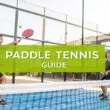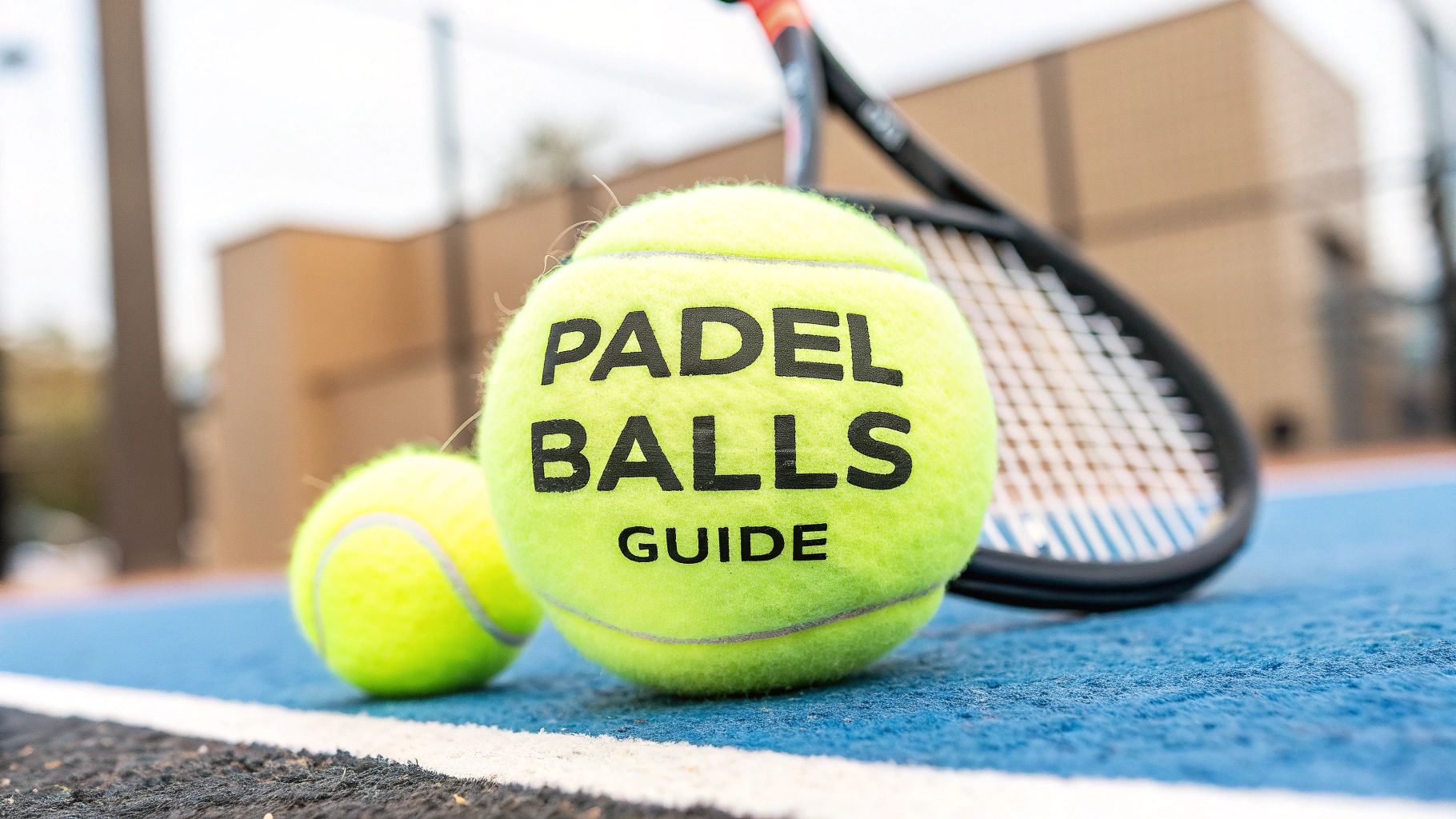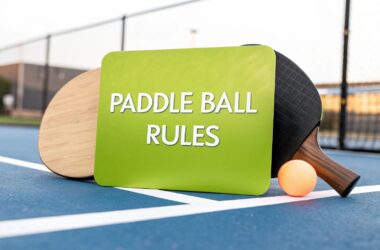It's easy to assume all padel balls for sale are pretty much the same. But here's the thing: the ball you play with is just as crucial as the racket in your hand. It has a massive impact on the speed, bounce, and overall feel of every single point.
Choosing the right ball for your skill level can be the difference between a frustrating match and a great one.
Finding the Right Padel Balls for Your Game
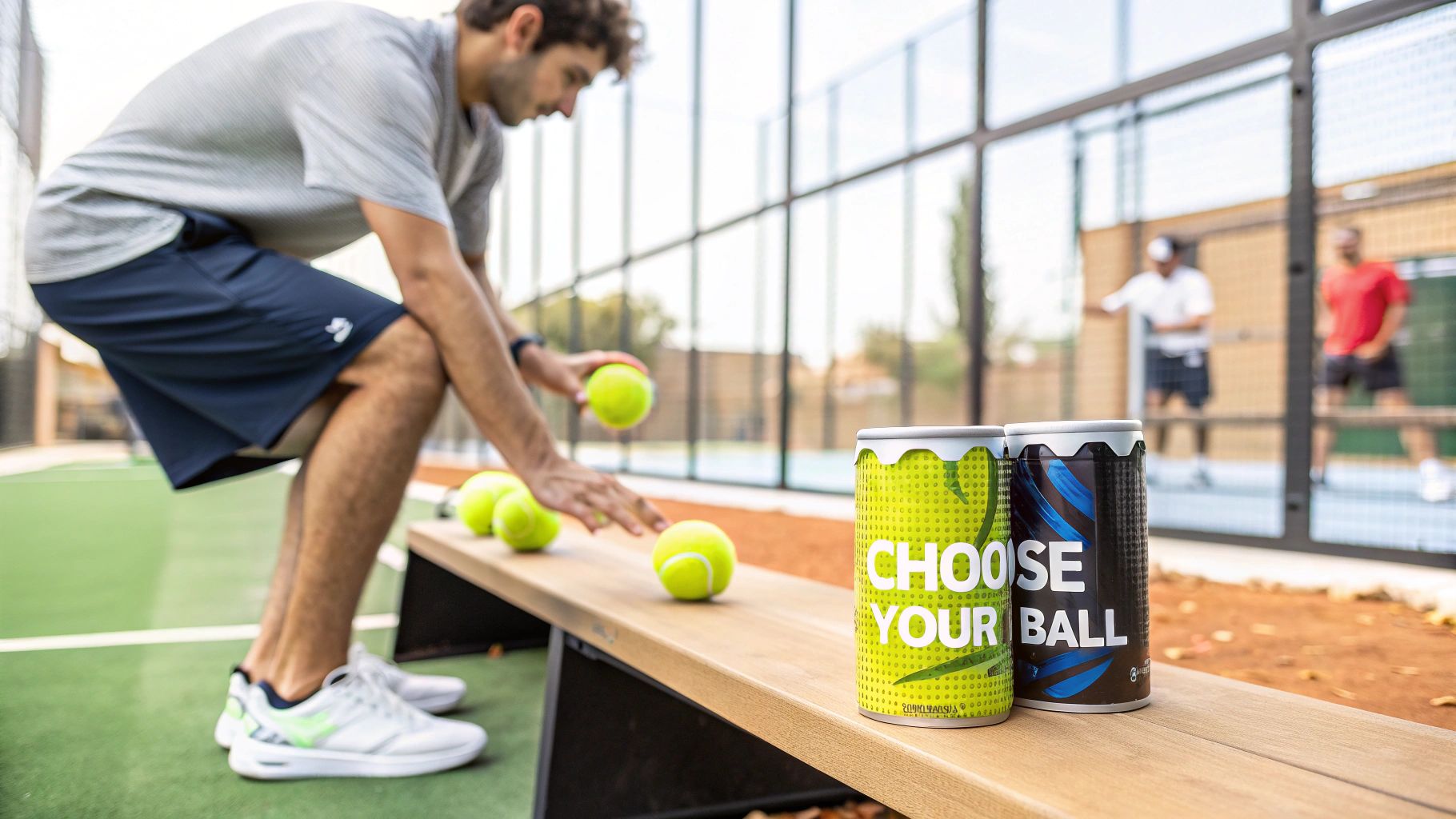
Welcome to the only guide you'll need to find the perfect padel balls. Think of the ball not just as a piece of equipment, but as a key variable that dictates how every rally plays out. Using a ball that's too fast for your level can kill rallies before they even start, while a ball that’s too slow can make the game feel sluggish and less exciting.

Buy the best padel gear to level up your next game!
CHECK OUT this deal from Padel Market!Get ready to take your game to the next level with the latest padel gear from Padel Market! Fast EU and Worldwide Shipping
We're here to cut through all the noise. We’ll get into everything that matters before you buy, from the internal pressure that gives a ball its pop to the felt exterior that grips the court and your racket face. Once you understand these pieces, you can pick a ball that truly fits your game.
What This Guide Covers
To help you sort through the options, we’ve broken everything down into simple, easy-to-digest topics. Our goal is to give you the confidence to choose the best gear for your needs.
Here’s what we’ll get into:
- Ball Anatomy: We'll look at what makes a padel ball tick, from its pressurized core to the type of felt it uses.
- Player Skill Levels: Find out how to match a ball's speed and control to where your game is right now, whether you're just starting or you're a tournament regular.
- Top Brand Comparisons: Get a straight-up comparison of the biggest names in the game and what makes their balls different.
- Smart Buying Strategies: Learn where to find the best deals and how to make sure you’re always getting fresh, quality balls.
Padel's growth has been explosive, and the demand for quality gear is through the roof. The padel sports market was valued at USD 250.75 million in 2024 and is on track to hit nearly USD 498 million by 2033. That surge comes from a player base that has ballooned from 10 million in 2017 to over 25 million today. That means more choices—and more competition—than ever. You can dive into the complete market analysis to see just how fast the sport is growing.
Key Takeaway: The best padel ball isn't about the brand or the price tag. It's about finding that sweet spot of speed, bounce, and durability that clicks with your style of play and helps you perform your best on the court.
Before we dive into the details, this quick guide below will give you a head start.
Padel Ball Quick Selection Guide
This table is a great starting point to quickly match a ball type to your playing style and the courts you usually play on.
| Ball Type | Best For | Key Characteristic | Ideal Player Level |
|---|---|---|---|
| Fast Balls | Aggressive, fast-paced games and slower, sandy courts. | Higher internal pressure, less dense felt for a quicker bounce. | Advanced & Competitive |
| Standard Balls | All-around play on most court types. | Balanced pressure and felt for predictable performance. | Intermediate to Advanced |
| Control Balls | Slower rallies, learning technique, and fast courts. | Lower internal pressure, thicker felt for a slower game. | Beginner to Intermediate |
Use this as a quick reference, and then read on to really understand the nitty-gritty of what makes each ball unique.
What Makes a Padel Ball Different
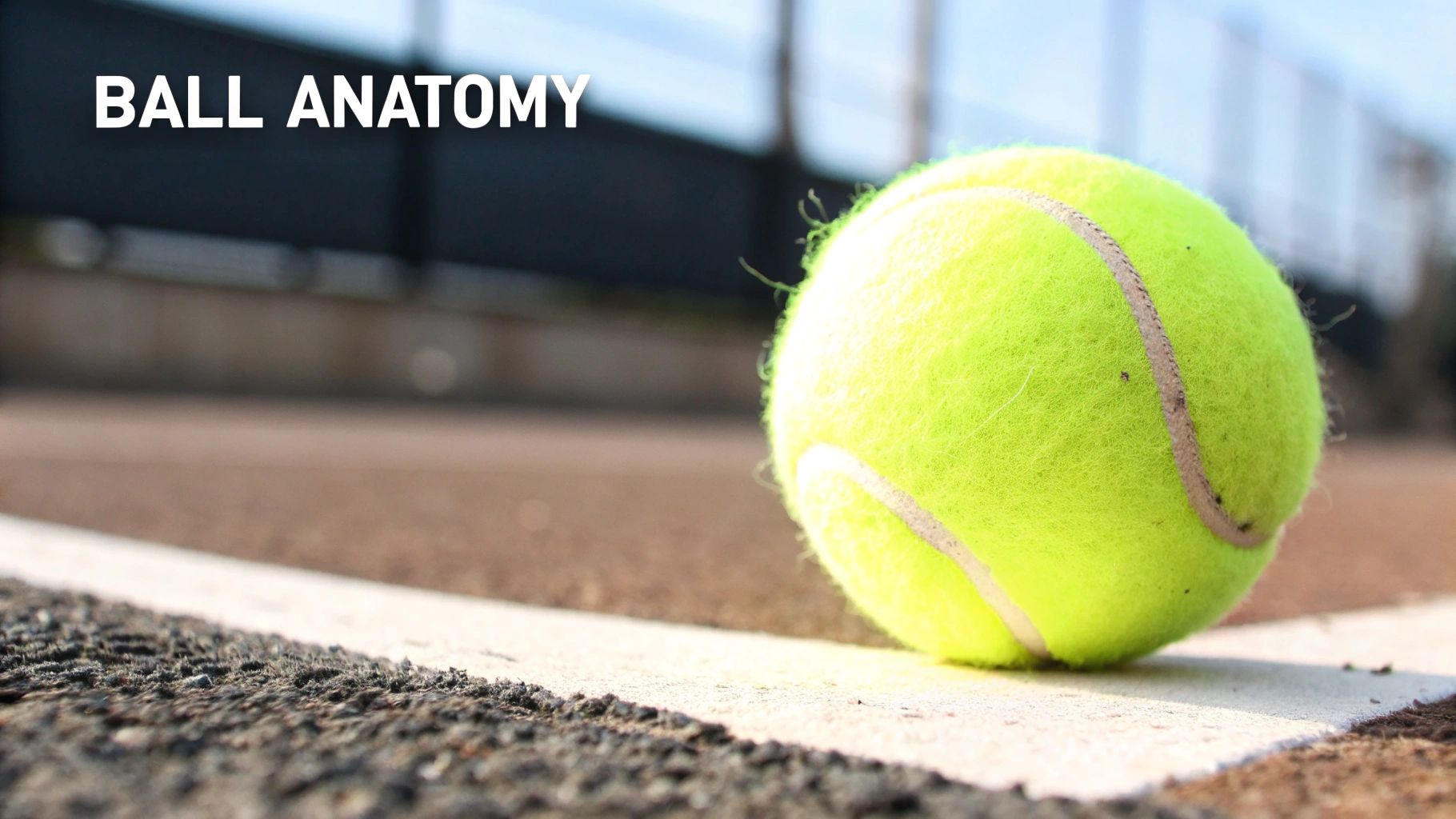
Before you start hunting for the best padel balls for sale, it's crucial to get a grip on what actually makes them tick. Pop open a can and they look almost exactly like tennis balls, right? But those tiny, almost invisible differences are what make the game of padel what it is.
The best way to think about it is like a car. The ball's internal pressure is its engine—it determines the power and speed. The fuzzy felt on the outside? Those are the tires, handling the grip, traction, and spin. For a padel ball to perform correctly, the engine and tires have to be perfectly matched for the unique demands of the court.
The Engine: Lower Internal Pressure
The biggest secret is on the inside. Padel balls are noticeably less pressurized than their tennis counterparts. The International Padel Federation (FIP) lays down the law here: a proper padel ball must have an internal pressure between 4.6 and 5.2 kg per 2.54 sq cm. A standard tennis ball packs way more punch.
This lower pressure is the magic ingredient for those long, strategic rallies that define padel. A softer, less pressurized ball means a slower, lower bounce. This gives players that extra split second to prepare a shot, especially when the ball comes off the back glass. Trust me, if you tried to play padel with a tennis ball, the game would be an uncontrollable, chaotic mess.
Why Lower Pressure Matters: A less bouncy ball is everything in padel. It shifts the focus from raw power to smart, patient play. It forces you to construct points using the walls and angles instead of just trying to blast winners past your opponents.
The Tires: Felt and Its Function
That fuzzy stuff on the outside—the felt—is the other half of the equation. It might seem like just a bit of fluff, but its texture and weave have a massive impact on how the ball flies through the air and reacts off the court.
Generally, the felt on a padel ball is a bit thicker with a longer weave than what you’d find on a tennis ball. This isn't just for looks; it's a deliberate design choice that creates more drag.

Buy the best padel gear to level up your next game!
CHECK OUT this deal from Padel Market!Get ready to take your game to the next level with the latest padel gear from Padel Market! Fast EU and Worldwide Shipping
- Slower Flight: That shaggier felt grabs more air, which slows the ball down mid-flight. This is key to keeping the ball inside the smaller, enclosed court.
- Enhanced Grip: The texture bites into the racket face, giving you the grip needed to execute those classic padel shots like the "bandeja" and "vibora" with heavy spin.
- Predictable Rebounds: It also helps the ball grip the glass walls, giving you those consistent, true bounces you can actually read and react to.
This blend of a softer core and a grippier felt is what creates the signature feel of a padel ball. It’s a design that’s been tweaked and perfected to match the sport's unique court and rules. The differences might seem small, but they’re huge in practice. To dig even deeper, check out this great breakdown of padel and tennis equipment in this detailed overview. Getting this right from the start means you’ll get way more enjoyment out of every single match.
Matching Padel Balls to Your Skill Level
Picking the right padel ball is a bit like choosing your first car. If you jump straight into a high-performance sports car, you'll likely spend more time spinning out than actually learning to drive. Start with something more forgiving, and you'll build skill and confidence. The ball you use can either be a great training partner or a frustrating opponent that holds you back.
It’s a classic mistake: a new player trying to control a professional-grade ball will spend the whole match chasing it down. On the flip side, an advanced player using a slow, fluffy beginner ball will feel like their shots have no teeth.
Let's break down which ball is right for you.
Beginner Level: Forgiving and Fun
When you're just starting, the name of the game is simply keeping the rally going. You need a ball that gives you that extra split second to get into position, set up your swing, and make clean contact. For this, you should be looking for balls made specifically for control and a slower game.
These balls usually have a bit less internal pressure and a thicker, fluffier felt. This combo makes them less "bouncy" and slows them down in the air, giving you that precious extra moment to react. Think of it as a ball with built-in training wheels—it’s forgiving and helps you build confidence fast.
- Key Characteristic: Slower speed with a lower, more predictable bounce.
- Why It Works: It keeps the ball in play longer, which means more reps for you. More reps mean faster learning of technique and court positioning.
- What to Look For: Brands often label these as "beginner," "training," or "control" balls.
Using these balls lets you focus on your form instead of just scrambling to survive the point. You'll build better habits from the get-go and, most importantly, have a lot more fun.
Intermediate Level: The Perfect Balance
Okay, so you've moved past the beginner stage. Your strokes are consistent, and you're starting to think about strategy—not just getting the ball over, but placing it where you want. This is when you graduate to a standard padel ball.
These are the workhorses of the padel world. They offer a great mix of speed, control, and durability. With standard pressure levels, they provide a much livelier bounce than beginner balls but are still tame enough for you to manage your shots and refine your technique.
This transition is a huge step in your development. A standard ball gives you honest feedback on your shots. You'll immediately feel the difference between a clean, powerful hit and a mishit, and that feedback is exactly what you need to improve.
Advanced and Competitive: Precision and Power
For the serious club player or tournament competitor, every little edge makes a difference. You need a ball that performs with absolute consistency and reacts exactly how you expect, shot after shot, even at high speed. This is where the high-performance or "pro" level balls come into play.
These balls are engineered for the top tier of the sport. They’re pumped to the highest allowable pressure for a faster, more dynamic game and wrapped in premium, durable felt that holds its texture longer. The result? A ball that flies true, bounces predictably, and lets you put some serious spin on it.
When you're looking for padel balls for sale for a tournament, these are the ones you want. They reward great technique with superior performance, giving you the confidence to unleash those sharp viboras and powerful smashes.
Comparing the Top Padel Ball Brands
Trying to navigate the crowded market of padel balls for sale can honestly feel a bit overwhelming. Every brand claims they've got the secret sauce for the best performance. But here's the thing: while most balls share a similar basic construction, the top manufacturers set themselves apart with tiny, but crucial, engineering tweaks in pressure, felt, and durability.
Getting a handle on these differences is the key to finding a ball that not only feels right for your game but also gives you the best bang for your buck. Let's break down the big names in the padel world—Head, Bullpadel, Nox, and Babolat—and see what makes each one tick.
Head: The Tournament Standard
Head is probably the most recognized name in the padel world, and for good reason. Their balls are the official choice for major pro tours, which pretty much makes them the gold standard for quality and consistency.
The flagship Head Padel Pro and its speedier cousin, the Pro S, are built for serious, competitive play. They pack a highly pressurized core and premium felt, giving you a fast, reliable bounce that rewards powerful, precise shots. Players constantly rave about their durability, mentioning they keep that fresh-out-of-the-can "pop" way longer than most competitors.
- Best For: Advanced and competitive players who need that tournament-level consistency.
- Key Feature: Unbeatable durability and a lively, predictable bounce.
- Price Point: Definitely premium, sitting at the higher end of the market.
This visual guide is a great way to see how ball types match up with a player's journey from beginner to pro.

As the infographic shows, once your skills improve, you naturally graduate from slower, control-focused balls to the faster, high-performance options.
Bullpadel: The Player-Focused Innovator
Bullpadel has carved out a reputation for making gear that’s built directly from player feedback. Their balls, like the super popular Bullpadel Premium Pro, are famous for striking a perfect balance between speed and control. That makes them a huge hit with a massive range of players.
What really sets Bullpadel apart is its focus on feel. The felt is often described as being a little softer, which gives you amazing grip on the racket face—a dream for players who live and die by spin-heavy shots like the vibora and bandeja. While they’re plenty durable, some players note they tend to fluff up a bit faster than a Head ball.
Expert Insight: A lot of club players lean towards Bullpadel because the balls offer a slightly more forgiving and controlled game. They're perfect for those long, grind-it-out matches where consistency wins over pure, raw speed.
Nox: The All-Round Performer
Nox is a brand that just screams quality, and their balls are no different. The Nox Pro Titanium is a true workhorse, designed from the ground up to deliver reliable performance, match after match.
They hit that sweet spot right in the middle: a lively bounce that isn't crazy fast, and solid durability that appeals to both frequent players and club owners. If you're just looking for a dependable, no-nonsense ball that plays well no matter the conditions, Nox is a fantastic pick. Their consistency makes them a go-to for training sessions and club matches alike. For a deeper look at specific models, you can always check out the latest padel ball news and reviews to stay current.
Babolat: The Control Specialist
As a titan in the tennis world, it's no surprise Babolat has made a serious splash in padel. Their balls, like the Babolat Padel Tour, are often praised for delivering exceptional control and a fantastic feel.
Babolat balls tend to have a slightly lower bounce and slower flight path compared to the speed demons on the market. This makes them an incredible choice for players who build their game around strategy and placement rather than just raw power. They help extend rallies and give you that extra split-second to set up your shots, making them a top contender for intermediate players focused on leveling up their tactical game.
Top Padel Ball Brands Compared
To make the choice a little easier, here's a quick side-by-side look at what these top brands bring to the court.
| Brand/Model | Key Feature | Best For Player Level | Average Durability | Price Range (per can) |
|---|---|---|---|---|
| Head Padel Pro | Maximum consistency and speed | Advanced & Competitive | Excellent | $$$ |
| Bullpadel Premium Pro | Balanced feel with great spin potential | Intermediate to Advanced | Very Good | $$ |
| Nox Pro Titanium | All-around reliability | Intermediate | Good | $$ |
| Babolat Padel Tour | Enhanced control and slower play | Beginner to Intermediate | Good | $$ |
At the end of the day, the "best" brand really comes down to what feels right for you. Grab a can from each of these contenders and see for yourself which one complements your style and helps you dominate the court.
Getting the Most Out of Every Can
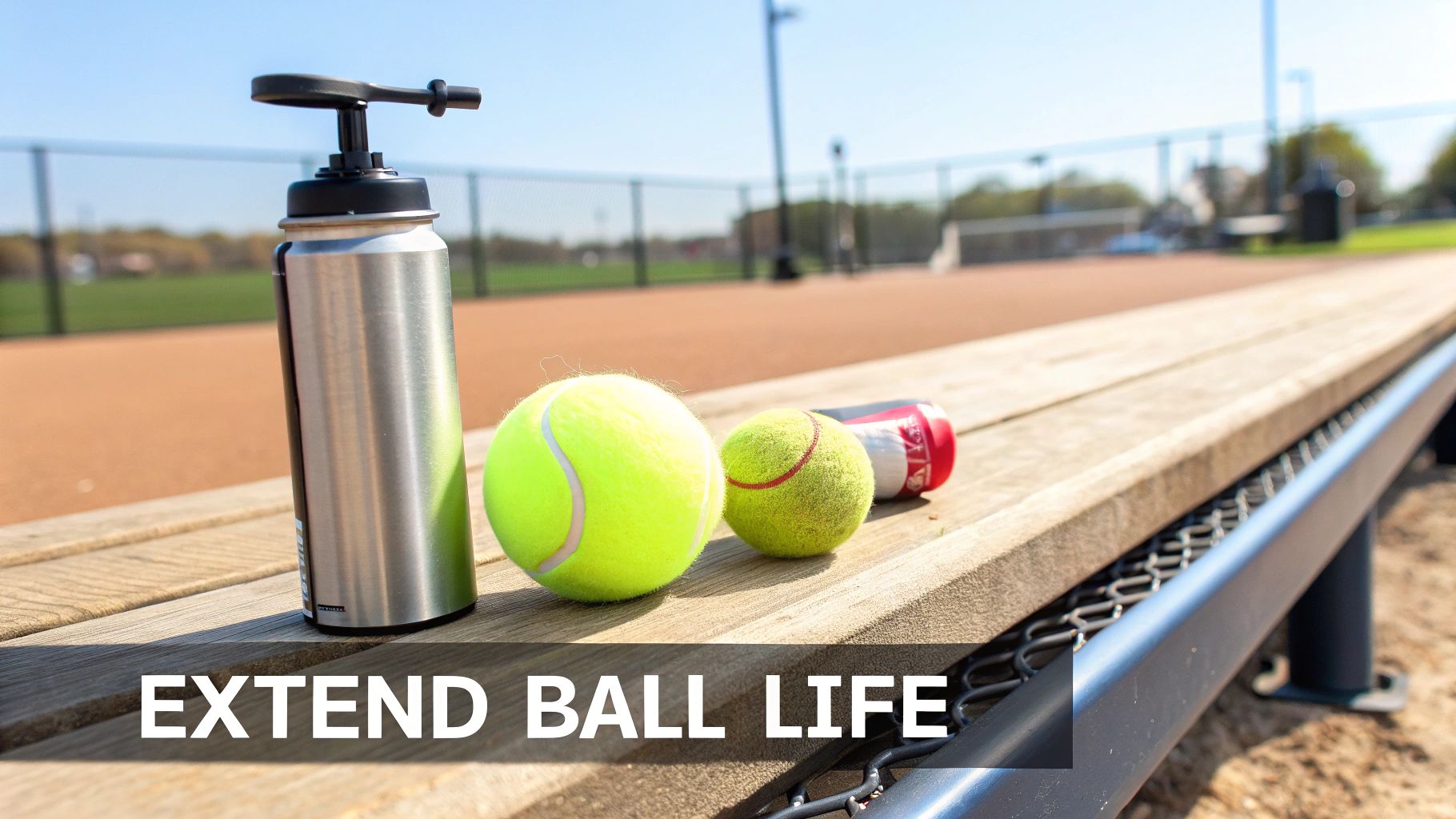
It's the question every player asks when grabbing a new tube of balls: "How long will these actually last?" Getting good value isn't just about the price on the can. It’s about understanding how long a ball stays playable and how to squeeze every last bit of performance out of it before it goes flat.
Nothing beats the crisp, lively feel of a fresh ball, but that feeling starts to fade with every single hit.
Think of a ball's internal pressure as its life force. Every time you smash, slice, or dink the ball, a tiny bit of that pressure escapes. At the same time, the felt on the outside gets roughed up and compacted. How quickly this happens depends on a few key things.
Factors That Affect Ball Durability
How long your balls stay fresh really comes down to where and how you play. A can that feels great for five matches in a cool, indoor club might die after just two games on a hot, gritty outdoor court.
- Playing Style: Are you an aggressive player who loves heavy topspin and powerful smashes? You're going to burn through balls much faster than someone with a softer, control-focused game.
- Court Surface: Older courts with a lot of sand act like sandpaper on the felt, stripping it down in no time. Newer, well-kept courts are much kinder to your gear.
- Climate Conditions: Heat is a ball-killer. It makes the rubber core softer and causes the internal pressure to drop way faster. Cold weather does the opposite, making balls feel hard and less bouncy.
How to Spot a Dead Padel Ball
Playing with a "dead" ball is one of the worst things you can do for your game. A worn-out ball has lost its pressure, giving you a low, sluggish bounce. This forces you to change your technique—you'll start swinging harder and flatter just to get the ball over the net.
Not only does this create bad habits, but it can also lead to arm injuries.
So, how can you tell it's time to pop open a fresh can?
The Bounce Test: This is the easiest way to check. Drop a ball from head height onto the court. A fresh ball should bounce back up to around your waist. If it's struggling to get much higher than your knees, its playing days are over.
Another dead giveaway is the sound. A new ball makes a satisfying, sharp "pop" off the racket. A dead one just gives you a dull, heavy "thud." Trust your ears and the feel—if the ball feels heavy and dead, it probably is.
Extending Ball Life and Sustainability
If you want to get more bang for your buck, look into a ball pressurizer. These gadgets store your balls in a sealed, pressurized container between matches. By keeping the internal pressure up, they can seriously extend the life of your balls. It's a small investment that pays for itself pretty quickly.
Beyond your own wallet, the sport is starting to tackle its environmental footprint. The average padel ball is only good for about 10 to 15 hours of play. With over 50,000 courts around the world, that's a mountain of discarded balls.
In response, some brands are launching recycling programs. In places like Spain, these efforts have already cut down ball waste by 10% since 2022. To dig deeper into these trends, you can learn more about the latest padel equipment research. By making smart choices, we can all maximize performance, save a little money, and help make padel a more sustainable sport.
Where to Find the Best Padel Ball Deals
Knowing what makes a great padel ball is only half the battle—finding them at the right price is the other. The good news is that with the sport's booming popularity, there are more places than ever to find quality padel balls for sale. Your mission is to find that sweet spot where convenience, price, and quality all line up.
You've basically got three main options: specialized online padel stores, the big e-commerce giants like Amazon, and your local club’s pro shop. Each one has its own advantages. The online specialists often have expert advice and a hand-picked selection, while the big retailers compete on price and how fast they can get the balls to your door. And don't forget your local pro shop; you get the balls instantly and support your community club at the same time.
Online Retailers vs Local Pro Shops
For a lot of players, online shopping is just easier and often cheaper. Websites that focus on padel and tennis gear usually have the widest selection. This is where you'll find newer brands and models that your local shop might not stock. It's also the best place to find aggressive bulk deals that can seriously lower your cost per can.
On the other hand, there’s a lot to be said for building a relationship with your local pro shop. You can actually hold the cans and check them to make sure they're fresh and properly pressurized. Plus, the staff can give you personalized tips based on how you play and the specific conditions of your local courts. They might be a little more expensive, but getting the balls right away and tapping into that expertise can be worth it.
Shopping Smart Online: When you're buying online, always take a minute to check the seller's return policy and skim through recent reviews. A good seller will guarantee you're getting fresh, authentic products, so you don't end up with old, depressurized duds that play like a dead ball from the very first hit.
Proven Strategies for Saving Money
No matter where you end up shopping, a few smart strategies can make your budget go a lot further. The single most effective tactic is buying in bulk. Grabbing a case of 18 or 24 cans can often slash the price per can by 15-25%, which is a huge saving for any regular player. Plus, you’ll always have a fresh supply ready for your next match.
You should also keep an eye out for seasonal sales and promotions. A lot of retailers run discounts around major holidays or right before a new season kicks off. Signing up for brand newsletters is another solid way to get a heads-up on sales and grab some exclusive coupon codes. Even major sports retailers can offer some unexpected savings, like those offering special Sportsdirect student discounts.
Here are a few more quick tips:
- Follow Brands on Social Media: Companies love to announce flash sales and special offers to their followers first.
- Price Comparison Tools: Use an online tool to quickly compare prices across a bunch of different retailers before you click "buy."
- Club Discounts: Ask at your club! Many have partnerships with brands that give members a nice discount on gear, including balls.
And if you're thinking about upgrading your racket, sometimes you can find bundle deals. Check out our guides on the latest padel rackets to see what's new. By mixing and matching these tactics, you can secure the best deals without ever having to compromise on quality.
Common Questions About Padel Balls
As you start shopping around for padel balls for sale, you'll find the same questions tend to crop up. Getting solid answers to these last few queries is the final step to buying with complete confidence. Let's tackle the most common concerns to clear up any lingering doubts you might have.
My goal here is to give you the practical knowledge you need to feel totally prepared. We'll dive into the specifics that both new and seasoned players often ask about.
Can I Use Tennis Balls for Padel?
This is, without a doubt, the most frequent question we hear. The answer is a hard no. While they look almost identical, using a tennis ball for padel would completely ruin the game. Tennis balls are way more pressurized, which makes them much faster and gives them a crazy high bounce.
That extra bounce would make controlling the ball off the glass walls a near-impossible task. The slow, strategic rallies that make padel so addictive would be gone, replaced by a frantic scramble to keep up. Padel balls are engineered with lower pressure for a reason—to create that controlled, tactical experience we all love.
Key Insight: The lower internal pressure in a padel ball isn't a small detail; it's the very thing that makes the sport work. To enjoy the game as it’s meant to be played, you absolutely have to stick with proper padel balls.
How Often Should I Replace My Padel Balls?
How long a can of balls lasts really comes down to how often and how hard you play. If you're a casual player hitting the court once a week, a can of balls should feel fresh and play well for about 3-4 matches. After that, you'll start to notice they just don't pop like they used to.
For serious club players and competitors, the standard is much stricter. Most will crack open a new can for every single match to ensure a perfectly consistent bounce and speed. A ball is officially "dead" when its bounce is noticeably low or when the felt gets too fluffy, which slows it down as it flies through the air.
What Is the Difference Between Pro and Championship Balls?
When you're browsing for balls, you'll often see terms like 'Pro' and 'Championship.' These are basically performance tiers, and here's the breakdown:
- 'Pro' or 'Tournament' Balls: These are the best of the best. They’re made for maximum consistency, speed, and durability and are often the official balls used on the professional tours.
- 'Championship' or 'Team' Balls: Think of these as a slight step down, perfect for regular club play, league matches, and training sessions. They offer reliable performance at a much friendlier price.
For most intermediate players, 'Championship' balls hit that sweet spot between quality and value. If you're playing competitively, though, you'll definitely feel the benefit of stepping up to the 'Pro' level balls.
At Padel Rumors, we're all about helping you find the perfect gear for your game. Check out our in-depth reviews and guides to make sure your next purchase is the right one. Visit us at https://www.padelrumors.com to learn more.



